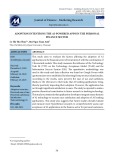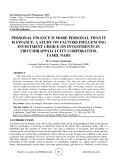
http://www.iaeme.com/IJM/index.asp 136 editor@iaeme.com
International Journal of Management (IJM)
Volume 8, Issue 6, Nov–Dec 2017, pp. 136–151, Article ID: IJM_08_06_015
Available online at
http://www.iaeme.com/ijm/issues.asp?JType=IJM&VType=8&IType=6
Journal Impact Factor (2016): 8.1920 (Calculated by GISI) www.jifactor.com
ISSN Print: 0976-6502 and ISSN Online: 0976-6510
© IAEME Publication
AN INTERVAL ENTROPIC ESTIMATION OF
CONSUMER PRIORITY IN MULTI-ATTRIBUTE
BEHAVIOURAL ENVIRONMENT – A CASE
STUDY OF FINANCIAL INVESTMENT
INSTRUMENTS IN AN URBAN VISTA
Dr. Ayan Chattopadhyay
Associate Professor – Marketing,
Army Institute of Management Kolkata, India
Pawan Gupta
Sales Trainee (Trade Marketing & Distribution) - ITC Ltd.
Independent Researcher; MBA 19 - Army Institute of Management Kolkata
ABSTRACT
The service sector in India has witnessed revolutionary change after liberalization
of the economy in early 90s and the financial investment sector too experienced
exponential growth with the continuous emergence of new financial instruments and
rapid change in consumer behaviour. One has witnessed a radical shift in retail
investment pattern from the conventional fixed deposits in a bank to different financial
instruments - equity, mutual funds, insurance, PPF, real estate, debentures or bonds,
precious items to name a few. However, reports on retail investment in different
instruments show big disparity. Though considerable research have been found on the
role and importance of such financial instruments, existing literature shows the dearth
of studies on behavioural aspect, especially related to attitude and preference or
consumer priority towards multi-attributes that influence behaviour or preference
comparison between different financial investment instruments. The researchers in the
present paper first explore consumer behaviour through attitude and preference study
towards four financial investment instruments; namely fixed deposit, equity, mutual
fund and insurance. Secondly, comparison between the four instruments has been
done. Both these studies were done using a highly popular method of Semantic
Differential Scaling. The researchers also make a modest effort in predicting the
extent to which the consumer priority in a multi-attribute behavioural environment
fluctuates for each of the four instruments and applied the unique interval entropy
approach as a potent method towards measuring the same. Primary survey forms the
basis of this study and Kolkata city is chosen as the urban vista.
Key words: Consumer attitude, Preference, Interval entropy Approach, Semantic
differential scaling, financial investment instrument.

An Interval Entropic Estimation of Consumer Priority in Multi-Attribute Behavioural Environment –
A Case Study of Financial Investment Instruments in an Urban Vista
http://www.iaeme.com/IJM/index.asp 137 editor@iaeme.com
Cite this Article: Dr. Ayan Chattopadhyay and Pawan Gupta, An Interval Entropic
Estimation of Consumer Priority in Multi-Attribute Behavioural Environment – A
Case Study of Financial Investment Instruments in an Urban Vista. International
Journal of Management, 8 (6), 2017, pp. 136–151.
http://www.iaeme.com/IJM/issues.asp?JType=IJM&VType=8&IType=6
1. INTRODUCTION
The past few decades has witnessed a radical shift in the way financial markets have evolved.
This has not just been a phenomenon in select geographies but a global phenomenon. The
world has seen great innovations in the financial investment instruments which have benefited
consumers in borrowing, transacting and investing; resulting in a great upsurge of the retail
financial business. However, the scenario in India has started changing only after the
economic reforms of 1991. The pre-reforms period since independence saw a very limited
opportunity in retail financial sector. The market consisted of a mix of public and private
enterprises operating under the state control and after nationalization of banks in India it was
the public sector that remained dominant in this sector. The major operators were the public
sector banks, post offices and Life Insurance Corporation of India, who had limited offerings
for the consumers. Traditional instruments dominated this phase which included savings bank
account, fixed deposit and recurring deposits from banks while the post offices offered term
deposit, National Savings Certificate, Kishan Vikash Patra and LIC offering life insurance
endowment plans primarily. In India, the post liberalized era since 1991 have also promoted
the boom in financial investment sector with multiple financial companies grappling against
each other by extending the best of offers and services to consumers to attract investment.
Consumer service has witnessed a new dimension altogether. Opening up of the economy has
also made technology transfer enter India with ease which also has made drastic changes in
the financial sector. Both service orientation and technological advancement in the financial
sector has made possible for consumers opening bank accounts, operating them, and making
transactions at the click of a button if one just looks at the banking system. The phenomenon
is not just restricted to banking system but spread across diverse financial investment
instruments. Consumers have plethora of choice before they make any financial investment
decision. The risk-return equation, the ease of investment, the ease of payment or the multiple
payment option modes are all being looked into by today‟s consumers. Even many of the
investment options are so flexible that it suits every Indian pocket, as if it is a tailor made
offer. Many new instruments have been introduced which Indian consumers have never heard
off; mutual funds, unit linked mutual funds, children‟s education plan, and education loans to
name a few. This has been possible by participation of private and foreign players over and
above the public sector enterprises. The entire portfolios of financial investment instruments
have been targeted at the both urban and rural Indian consumers, but the spread or business
share is primarily restricted to the urban area. The new and innovative instruments have
gained more popularity in the urban vista compared to rural India. This may be attributed to
the concentrated activities of the financial sector players in urban areas, lower level of
awareness and education in the rural areas and a traditional mindset in rural areas that is
averse to risk taking. But with nearly two-thirds of the population still living in rural areas in
India the focus has started shifting towards rural India too.
Performance of different or new or relatively new financial investment instruments have
not been the same even in urban areas; and many organizations are finding it hard to make an
inroad in the consumer‟s consideration set. The widely varying consumer behavioural
response is a matter not fully discovered by most of the financial services companies. While
such organizations are going all out to increase awareness, extend greater benefits, ensure

Dr. Ayan Chattopadhyay and Pawan Gupta
http://www.iaeme.com/IJM/index.asp 138 editor@iaeme.com
service guarantee, improvise on the intangible components and so on; yet the thorough
understanding of the consumer behaviour and attitude towards investments is still a matter of
concern. Attitude and behaviour of consumers, their ability to risk the newer forms of
investment is on a constant change path. But what does one understand from the word attitude
or behaviour? Or link between the two. One may understand attitude as "a relatively enduring
organization of beliefs, feelings, and behavioral tendencies towards socially significant
objects, groups, events or symbols" (Hogg & Vaughan 2005); "a psychological tendency that
is expressed by evaluating a particular entity with some degree of favor or disfavor" (Eagly &
Chaiken, 1993). One of the underlying assumptions about the link between attitudes and
behavior is that of consistency. This means that we often or usually expect the behavior of a
person to be consistent with the attitudes that they hold which is also called the principle of
consistency. The principle of consistency reflects the idea that people are rational and attempt
to behave rationally at all times and that a person‟s behavior should be consistent with their
attitude(s). The strength with which an attitude is held is often a good predictor of behavior.
The stronger the attitude the more likely it should affect behavior.
The strength of the attitude is related to its personal relevance which means how
significant the attitude is for the person and relates to self-interest, social identification and
value. If an attitude has a high self-interest for a person, it is going to be extremely important.
As a consequence, the attitude will have a very strong influence upon a person's behavior. By
contrast, an attitude will not be important to a person if it does not relate in any way to his/
her life. Attitudes influence the way we think and behave and are therefore important for the
marketers who study them to understand how a consumer behaves. The formation of attitude
is dependent on numerous attributes; also known as attitude builders. Thus in a multi attribute
behavioural environment, some attitude builder has a greater impact on the overall attitude
formation or behavioural outcome i.e. attitude builders have a priority that is individual
specific. In the present paper, a modest effort to measure attitude towards different financial
investment instruments have been undertaken along with finding the priority of attitude
building attributes. Past research works form the backbone of evaluating and identifying the
parameters that constitute the multi-attribute behavioural environment.
2. EXPLORING PAST STUDIES
Study of past studies (literature) on financial investment instruments and that too related to
consumer attitude and behaviour suggests that while considerable studies in Indian context
have been made on the core product, studies on consumer behavioural aspect have received
low focus. This may be because of the fact that the onset of globalization that had brought in a
drastic change in the financial investment domain is not a very old phenomenon in India
compared to the other developed countries across the globe. In this context it is worth
mentioning some of the related researches. Francis J. C. (1986) revealed the importance of the
rate of return in investments which primarily guides consumer buying. Singh P. (1986) opined
that understanding and measuring return and risk is fundamental to the investment process by
consumers. According to her, most investors are 'risk averse' and to have a higher return the
investor has to face greater risks. Madhusudhan V. (1996) conducted a study on mutual funds
that reveals that investors look for safety of their invested amount, liquidity and growth or
appreciation of their capital in the order of importance which acts as a major differentiating
factor in the selection of mutual fund schemes. Study by Sikidar S. (1996) on the behavioural
aspects of the consumers in the North Eastern India, primarily towards equity and mutual
funds investment reveal that these instruments are merely viewed as tax savings instruments.
Goetzman and Peles (1997) established that there is evidence of investor psychology affecting
fund/scheme selection and switching. Chakrabarti A. & Rungta H. (2000) stressed the

An Interval Entropic Estimation of Consumer Priority in Multi-Attribute Behavioural Environment –
A Case Study of Financial Investment Instruments in an Urban Vista
http://www.iaeme.com/IJM/index.asp 139 editor@iaeme.com
importance of brand effect in determining the consumer behaviour towards mutual fund
scheme buying. Shanmugham (2000), studied the perceptions of various investment strategy
dimensions and the factors motivating investment decisions. The study highlights that among
the various factors, psychological and sociological factors dominated the economic factors in
investment decisions. Martenson R. (2005), describes that consumer knowledge, involvement,
and risk are central concepts in consumer behavior research in financial investments. The
hypothesized importance of domain specific knowledge was confirmed and a mediation
analysis showed the relations of involvement and risk willingness to knowledge and returns.
According to Jain R.( 2005), government backed savings instruments that offer a high rate of
assured returns and safety assurance of investors capital are preferred to mutual funds and
equity. The study also points out that Indians still have a risk-averse mentality that keeps
majority of the investments away from mutual funds and equity. Omar and Frimpong (2006)
stressed the importance of life insurance and regarded it as a saving medium, financial
investment, or a way of dealing with risks. Alinvi & Babri (2007) are of view that customers‟
preferences change on a constant basis, and organizations adjust in order to meet these
changes to remain competitive and profitable. Das B. et. al. (2008) made the behavioural
analysis of retail investors with reference to mutual funds and life insurance. The study
reveals that majority of the people (35%) are investing with the objective of capital growth,
followed by tax saving (28%) and only 17% are investing for the retirement plan. Maximum
investors (30%) like to invest in life insurance followed by mutual fund (20%) & Government
saving schemes (18%). O‟Donnel N. (2011) highlighted the importance of Risk as a
determinant to attitude formation in investment decision. While safety, security, complexity
(or convenience) are few of the attitude builders in financial investments as suggested by
Sarkar et. al. (2012), transparency and flexibility in financial investment instruments was
identified by Brian D (2010). Singh J. et. al. (2004) describes investor‟s perception and
attitude formation is dominantly guided by small investment option possibility and SIP is an
innovative option in that. Past studies explored provided not only valuable insights about
financial investment instruments in Indian context but also helped in building a foundation for
exploring the research gap.
3. RESEARCH GAP
Financial investment instruments have always been an area of interest in both academic as
well as industry fraternity. Umpteen number of research work have been conducted across the
globe, especially in the developed economies on the core instruments itself, factors promoting
consumer investments in financial instruments, consumer behaviour and psychology towards
different investment instruments in the developed economies. Even in Indian context one may
find considerable researches on the benefits or utility of such financial investment
instruments, especially how one instrument is different from the other and the differential
advantages of these instruments. However, the number of studies related to consumer attitude
and behaviour towards such instruments, primarily those which have gained prominence in
the globalized era are limited in Indian context. The researchers have identified the limited
study on the attitudinal and behavioural aspect towards the different financial investment
instruments as the gap area for their present study also restricted their study to four financial
investment instruments, namely Mutual Fund, Fixed Deposit, Equity and Insurance and
further restricted the geographic domain within the urban vista of Kolkata city.

Dr. Ayan Chattopadhyay and Pawan Gupta
http://www.iaeme.com/IJM/index.asp 140 editor@iaeme.com
4. RESEARCH OBJECTIVES
The researchers, on the basis of the research gap have framed two objectives in the present
study. Comparing overall consumer attitude towards different financial investment
instruments.
Evaluating and understanding the priority or weights of each of the multi-attribute attitude
building parameters that guides consumer behaviour for all the financial investment
instruments separately.
5. RESEARCH FRAMEWORK
The researchers in the ensuing study chose descriptive research design and cross sectional
study were preferred to longitudinal study since the objectives set suit the former study design
more. The research uses interval entropic method to determine the priority of consumers
towards different attitude forming attributes. This method assumes probabilistic or random
nature of drawing samples from the population. In order to bring in randomness in the sample
selection process, random sampling method was adopted so as to meet the criteria of the
interval entropic method. For the purpose of random sampling, sampling frame is required
from which the sample is to be drawn. Telephone directory of Kolkata forms the sample
frame to source the name and phone numbers of the probable respondents. Randomness in
selection process has been maintained by using the random number table. From the random
number table the researcher chose the random numbers between the Kolkata telephone
directory page range; 8 to 784. Pages with those numbers were selected for drawing the
sample. Then the first two names and the last two names from each page were taken along
with the respective telephone numbers from all the randomly selected pages. Thus for
Kolkata, 280 names with their telephone numbers were listed. In order make a comparative
analysis about consumers' attitude towards the different financial investment instruments,
primary survey method using questionnaire forms an integral part of the research design.
Before the full scale survey was rolled out with the chosen sample, a pilot survey was
administered to identify and eliminate the flaws. This survey had 30 respondents selected on
the basis of the fact that they are regular investors in multiple financial investment
instruments. Pilot survey helped in concluding that the questionnaire was good enough to be
used for the full scale survey and it is simplification of language that was required to bring in
clarity to certain questions. For the purpose of data collection, individuals were contacted and
time sought from them after explaining in brief the objective of the study. The response was
mixed as the probable respondents accepted and also declined in some cases to participate in
the survey. In most cases the respondents were comfortable in filling up the questionnaire
online and the link of the questionnaire (google form) was sent to such respondents for their
responses. For others, the questionnaire was filled through face to face interview. The filled in
questionnaires were then scrutinized and the incomplete ones rejected. It was found out that
on an average the respondents took 20 minutes to fill up the questionnaire. The sample size
was calculated to be 137 using the standard sample size calculator (Bartlett, J. E, et al., 2001).
230 number of questionnaires was distributed out which 121 filled in valid questionnaires
were received, thus getting a 52.6 % rate of return. It took 4 months to complete the survey. In
social science research, where an attitude scale or some other rating scales are being used, it is
very important that the investigator evaluates the extent to which random error effects the
measurement. Reliability Tests gives a measure of the extent to which the results are free
from experimental or measurement errors. Out of the various methods of measuring the
reliability of an instrument, the researcher used internal consistency coefficients. Cronbach‟s
(1951) alpha reliability coefficient was used to estimate the reliability in the present case and
its value was calculated using SPSS Ver. 20. The reliability statistics output reveal a value of




















![Đề thi Tài chính cá nhân kết thúc học phần: Tổng hợp [Năm]](https://cdn.tailieu.vn/images/document/thumbnail/2025/20251015/dilysstran/135x160/64111760499392.jpg)


![Câu hỏi trắc nghiệm và bài tập Thị trường chứng khoán [mới nhất]](https://cdn.tailieu.vn/images/document/thumbnail/2025/20251001/kimphuong1001/135x160/75961759303872.jpg)


